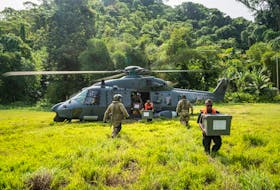Volunteer members of the Queens County Fish and Game Association support the conservation of fish, wildlife and habitat in this area of Nova Scotia. Our association is an affiliate of the Nova Scotia Federation of Anglers and Hunters and the Nova Scotia Salmon Association.
The 2017 Atlantic salmon count at the LaHave River Morgan Falls trap to Oct. 31 was 26 salmon and 192 grilse for a total of 218 fish. The 2016 returns were 45 salmon and 43 grilse for a total of 88 fish. Conservation escapement requirement at that location is 1,320 fish. The federal fisheries minister is now expected to make an endangered-listing decision in the summer of 2018 on local Atlantic salmon. Annual delays for that decision seem to be a normal occurrence.
Previous illegal introductions of chain pickerel and mall mouth bass continue to reduce our local trout and salmon populations. The Nova Scotia Department of Fisheries has partnered with Kejimkujik National Park staff in an attempt to remove small mouth bass from Cannon Lake in West Caledonia, in an effort to prevent an invasive species from accessing the park. A total of 199 small mouth bass were removed in 2017. The Canada 150 celebrations included free access to federal parks in 2017, which significantly increased visitation to Kejimkujik.
Nova Scotia Power filed an application with the Nova Scotia Utility and Review Board in November 2017 to receive approval for Capital Expenditures related to upgrading the Mersey River Hydro System. The generating station at McGowan Lake on the Medway River system was removed in 2017; however, the dam will be maintained to support fish and wildlife habitat in the McGowan Lake head pond area.
Provincial fisheries staff at McGowan Lake Trout Hatchery continued to enhance local angling locations, including the Christopher Lake Trophy Trout fishery, Hidden Hills Lake, Victoria Lake and many other locations.
The Nova Scotia Guides Association continues to lease our Fish and Games land at Hibernia. We are pleased with their management of our property.
The UNESCO Southwest Nova Scotia Biosphere Reserve Association continues to support all five counties in Southwestern Nova Scotia, source financial support towards visitor promotion efforts, and the creation of an Interactive Science Atlas database. The Biosphere Successfully passed the UNESCO periodic review process to maintain its designation.
Fisheries and Oceans conducted public consultations in 2017 pertaining to introducing a Recreational Salt Water Angling Licence. Our position is that the licence allows retention of one halibut over 81 centimeters per day, as well as other species. This licence must be at a reasonable fee, and if all species are not included under that licence, the license should be free.
Pressure is also being applied to Environment Canada to have the department meet its fiduciary responsibility to return to properly testing water in tidal areas to determine water quality and food safety, as well as allowing unpolluted clam flats to again be open to recreational clam harvesting. The potential negative health impacts to residents and visitors due to these cutbacks are significant.
Gaspereaux catches in local rivers in 2017 appear to be similar to 2016.
The Medway Community Forest Cooperative is presently in the process of re-negotiating its Crown land lease. Research was conducted in 2017 to determine the impacts of fires on leased lands that burned in 2016.
While residents continue to request motorized access to the main Crown road from the Kedge River bridge, along the west side of Lake Rossignol to the West Brook gate area, the Department of Natural Resources is reluctant to take action to allow that motorized access to occur.
Residents report that the numbers of deer, rabbits and other wildlife vary throughout Southwestern Nova Scotia. This is mainly expected to be attributed to annual changes in local coyote populations as well as climate and weather events.
Our members continued to attend various meetings, participated on numerous government advisory committees and assisted government departments.
- Submitted by Louis Wamboldt, president, Queens County Fish and Games Association
Queens County Fish and Game Association shares annual report
STORY CONTINUES BELOW THESE SALTWIRE VIDEOS








